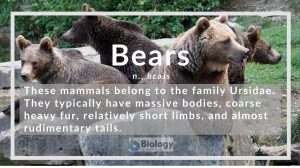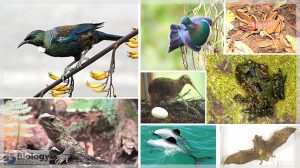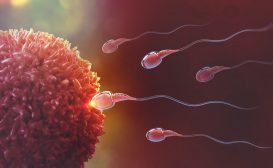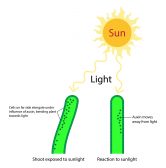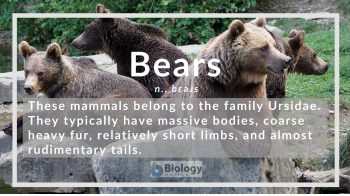
Bears
n., bɛəɹs
These mammals belong to the family Ursidae. They typically have massive bodies, coarse heavy fur, relatively short limbs, and almost rudimentary tails.
Table of Contents
Bears Definition
Bears are mammals belonging to the family Ursidae. They typically have massive bodies, coarse heavy fur, relatively short limbs, and almost rudimentary tails. Bears live mostly alone or in solitary. They are found throughout North and South America, Europe, and Asia. (Ref.1) During the winter season, bears in the Northern Hemisphere hibernate. Asiatic black bears, American black bears, and brown bears hibernate inside their dens. (Ref.2) Giant pandas, sloth bears, sun bears, Andean bears, and polar bears do not hibernate. (Ref. 2, 3)
Etymology: from Old English “bera”, which in turn, came from the Proto-Germanic “berô”
Form
The height of bears varies from 4 ft. to 8 ft. whereas the weight can be from 60 to more than a thousand pounds (Ref.1), e.g. 1400 pounds in male polar bears (Ref.2). They have an excellent sense of smell. They have nonretractable claws that help to dig for food. (Ref.4) Similar to humans, they are plantigrade, meaning they walk on the soles of their feet. In general, they have hairless soles with the exception of polar bears. Their soles have hair to enable them to walk on ice firmly. (Ref.4) Despite their massive size, many of them are skilled climbers and swimmers. Bears lack the clavicle bone. Males have a baculum. (Ref.4)
Hibernation and Diet
Bears in the Northern Hemisphere hibernate during winter. They are Asiatic black bears, American black bears, and brown bears. (Ref.2) During that season, food can get scarce. Therefore, they hibernate as a way to deal with food scarcity in winter. Their metabolism slows down so that energy expenditure could significantly be reduced. Going out to hunt food during this time of year is more energy-consuming than lowering down temperature, heart rate, respiration, and metabolism. Their energy source comes from a layer of fat, which they stored from the food they ate during summer and fall. If they fail to accumulate enough fat for the winter, they could die from starvation. (Ref.4) Giant pandas, sloth bears, sun bears, and Andean bears do not hibernate. (Ref.2) Polar bears also do not hibernate; they stay outside during winter. Pregnant polar bears may seem to be hibernating because they enter their dens and stay there for several months. However, they are in their dens to give birth and nurse their cubs for the first three months. (Ref.2,3) Their heart rate, metabolism, and breathing rate are lowered. Nevertheless, they do not reach the state of true hibernation. (Ref.3)
Their diet can be chiefly plant-based, meat-based, or both. For instance, giant pandas eat almost always bamboo whereas polar bears eat mostly meat (e.g. seals and fish). Black bears feed on insects, nuts, berries, grasses, and other vegetation. They may also hunt and feed on deer fawns and moose calves. For more info on the diet of the different bear species, see the table below.
| Bear Species | Diet |
|---|---|
| American Black Bear (Ursus americanus) | The diet is primarily plant-based. They feed chiefly on acorns, beechnuts, hickory nuts, huckleberries, blackberries, cranberries, grasses, herbaceous leaves, and stems. They may also feed on animal matter, e.g. insects (such as beetles and ants), small mammals, and salmon. |
| Andean Bear (Tremarctos ornatus) | Their diet chiefly consists of plants, e.g. bromeliads, figs, motilón fruits, cacti, palm frond petioles, orchid bulbs, cortex of pasallo tree, and bamboo shoots. They may also feed on animal matter, e.g. insects, rodents, ungulates, birds. Occasionally, they eat honey. |
| Asiatic Black Bear (Ursus thibetanus) and Sun Bear (Helarctos malayanus) | These two bear species have similar diets. Their diet consists primarily of fruits (e.g. figs, berries, drupes, acorns, stone pine seeds) and insects (e.g. ants, beetles, and termites). The sun bears, however, eat more insects than the Asiatic black bears. Other plant materials that these bears feed on are leaves, stems, flowers, and legume pods. Occasionally, they feed on birds, eggs, reptiles, fish, and small vertebrates. Additionally, sun bears also eat honey, earthworms, and mushrooms. |
| Brown Bear (Ursus arctos) | Their diet is the most versatile among the bear species. Coastal bears, for instance, feed on salmon (main food), moose, grasses, forbs, and berries. Interior brown bear populations have a diet consisting primarily of caribou, moose, bison, elk, and small mammals. They may also feed on insects (e.g. ants, yellow jackets, and army cutworm moths), grasses, forbs, berries, and seeds. As for the southern brown bear populations, their diet is primarily fleshy fruits (e.g. berries, rose hips, kiwi, and plums), hard mast (e.g. acorns and beechnuts), grasses, forbs, roots, tubers, seeds, and fungi. Asian brown bear populations consume mostly plant matter or vegetation. A small percentage of their diet comes from animal matter, such as insects (e.g. beetles and ants), ungulates, and small mammals (e.g. rodents). |
| Giant Panda Bear (Ailuropoda melanoleuca) | A large percentage of the giant panda diet consists of bamboo shoots and leaves, i.e. about 95–99%. |
| Polar Bear (Ursus maritimus) | Their diet consists chiefly of seals (especially, ringed seals). Occasionally, they prey on walruses, narwhal, and belugas. When on land, they feed on coastal marine organisms, such as plants (e.g. algae), invertebrates, birds, and eggs (e.g. snow geese). They also consume land plants (e.g. grasses, forbs, mosses, and berries), fungi (mushrooms), and animals (e.g. caribous and small rodents). |
| Sloth Bear (Melursus ursinus) | Their diet primarily consists of insects (e.g. termites, ants, and beetles). The rest includes fruits such as figs, dwarf date palm, black plum, and Lycium berries. They may also consume flowers, grass, honey, and carrion. |
Note: Data from Ref.5
Reproduction and Lifespan
Soon after mating, males and females separate. Gravid females in the Northern Hemisphere give birth in the den during winter whereas tropical bears give birth during 6 to 8 weeks prior to the fruit-ripening season. (Ref.2) The timing relates to the phenomenon of delayed implantation that occurs in many bear species. Females that are capable of delayed implantation mate in the summer breeding season. After conception, the fertilized egg develops into a blastocyst. However, embryonic development will be arrested at this stage. The blastocyst will remain dormant and unimplanted in the uterus. It will resume development and implant in the uterine wall in late November or early December and then the birthing of the cubs typically occurs in January or February. (Ref.6) Seasonal breeding and delayed implantation are not observed in the sun bears. They breed year-round. (Ref.7) Another exception is the giant panda. Although they exhibit delayed implantation they have a shorter gestational length. (Ref.7, 8) The giant pandas give birth to their young earlier than the other bear species. Researchers presume that the early birthing of their young is essential to their survival. Giant pandas do not hibernate. The young have to grow their fur to survive the cold during winter months. (Ref.8)
Cubs are born naked and blind and completely dependent on their mother for survival (altricial). (Ref.2) Bears are sexually mature by the age of 3.5 to 6 years. In the wild, bears live for 15 to 30 years. In captivity, their lifespan can be longer. (Ref.2)
Conservation and Threat
Many species of bears are considered vulnerable or endangered by the IUCN. They are illegally poached and traded for their meat and fur. Another reason they are illegally hunted and sold is the bear bile produced in their gallbladder for use in Chinese traditional medicine. (Ref.1) They also risk losing their habitats by illegal logging and other human activities. Climate change could also be a critical factor of habitat loss, especially for polar bears that live in the Arctic region, which is in danger of losing sea ice by melting.
Examples of Bears
At present, there are eight extant species of bears. They are as follows: (1) American black bear, (2) Andean or spectacled bear (Tremarctos), (3) Asiatic black bear, (4) brown bear, (5) giant panda (Ailuropoda), (6) polar bear, (7) sloth bear (Melursus), and (8) sun bear (Helarctos). (Ref.2) American black bear, Asiatic black bear, polar bear, and brown bear belong to the genus Ursus.
See also
References
- Bears. (2019, February 15). Nationalgeographic.Com. https://www.nationalgeographic.com/animals/mammals/group/bears-grizzly-polar-panda/
- Bears of the World. (2017). International Association for Bear Research and Management. https://www.bearbiology.org/bears-of-the-world/
- Do Polar Bears Undergo Walking Hibernation? – Polar Bears International. (2019). Polarbearsinternational.Org. https://polarbearsinternational.org/news/article-polar-bears/polar-bear-questions-do-polar-bears-undergo-walking-hibernation/
- bear | Description, Species, & Facts | Britannica. (2020). In Encyclopædia Britannica. https://www.britannica.com/animal/bear
- Fortin-Noreus, J. K., & Teunissen van Manen, J. L. (2019). Bear Diet. Encyclopedia of Animal Cognition and Behavior, 1–7. https://doi.org/10.1007/978-3-319-47829-6_1720-1
- Hellgren, E. C. (1998). Physiology of Hibernation in Bears. Ursus, 10, 467–477. JSTOR. https://www.jstor.org/stable/3873159?seq=1
- Frederick, C., Hunt, K. E., Kyes, R. C., & Wasser, S. K. (2012, April). Reproductive timing and aseasonality in the sun bear (Ursus malayanus). ResearchGate; Oxford University Press (OUP). https://www.researchgate.net/publication/261977147_Reproductive_timing_and_aseasonality_in_the_sun_bear_Ursus_malayanus
- Zhang, H., Li, D., Wang, C., & Hull, V. (2009). Delayed implantation in giant pandas: the first comprehensive empirical evidence. Reproduction (Cambridge, England), 138(6), 979–986. https://doi.org/10.1530/REP-09-0241
©BiologyOnline. Content provided and moderated by BiologyOnline Editors.
